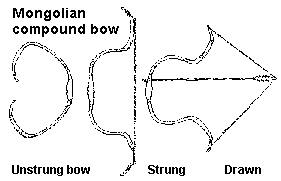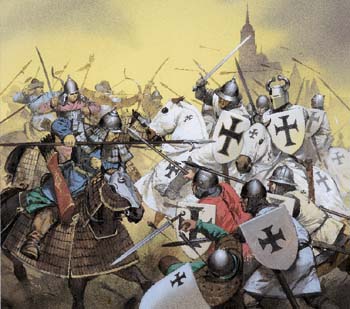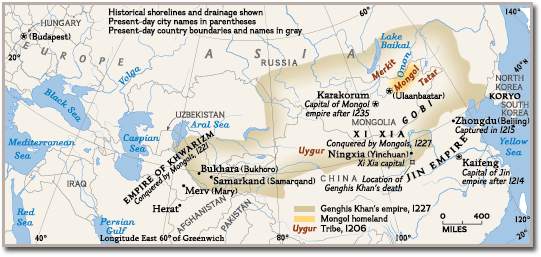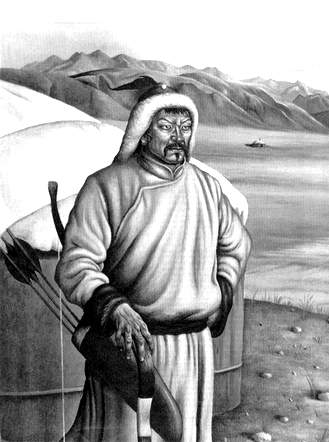All in all, Genghis Khan and his descendants subjugated large parts
of Eastern Europe, the Middle East, Central Asia and all of China.
His exploits are well known by most people, but many people do not know
why he was able to conquer lands so quickly and so effectively. Some
people simply believe it was just the strength of his horses. While
his sturdy Mongolian steeds did play a large role as they were able to
travel extremely far and seemed to be as durable as the men who rode them,
Genghis Khan also created one of the most loyal armies to date. There
are three major reasons why Genghis Khan was so successful in his campaigns.
The first of these reasons is the easiest to explain; they are his military
tactics and the technology the Mongols employed. These were quite revolutionary
for their time, especially for a group of nomads.
 It would seem strange to lump a horse together with technology, but there
is no doubt that these hardy ponies were a large part of the success of
the greatly outnumbered Mongols. Firing arrows from composite bows
on horseback, the Mongolian lightly armored cavalry decimated their opponents.
Western knights were trained to fight in hand-to-hand combat, and it was
not until the English longbow and muskets were invented that they slowly
changed to ranged combat. On the other hand, the Mongolians were
trained since childhood to ride a horse and shoot a bow. Not necessarily
for combat with other men, but simply for hunting animals and catching
runaways from the herd. However, this knowledge can readily be used
to fight against heavily armored, slow moving foes. At the time,
the Mongols’ preferred weapon of choice was the composite bow, which is
not given nearly enough credit for winning their battles. With a
range of roughly 350 yards and enough strength to rip through crude iron
armor, this bow is the first half of the winning equation for the Mongols.
In comparison, the English longbow only had a range of roughly 250 yards
and was fired in an arc, so the arrow mainly gained its power from gravity,
whereas the composite bow was fired more directly (Rossabi, 2). It
was said that each cavalryman from the horde carried at least 60 arrows
in their quiver, and that they were able to make accurate shots while charging,
retreating, or even when they had to turn around on the back of their horse
to fire their shot. It is clear that the Mongols used ranged warfare
extensively before its dominance in Western Europe, and they used it much
more effectively than anyone until modern times with the advent of guns.
It would seem strange to lump a horse together with technology, but there
is no doubt that these hardy ponies were a large part of the success of
the greatly outnumbered Mongols. Firing arrows from composite bows
on horseback, the Mongolian lightly armored cavalry decimated their opponents.
Western knights were trained to fight in hand-to-hand combat, and it was
not until the English longbow and muskets were invented that they slowly
changed to ranged combat. On the other hand, the Mongolians were
trained since childhood to ride a horse and shoot a bow. Not necessarily
for combat with other men, but simply for hunting animals and catching
runaways from the herd. However, this knowledge can readily be used
to fight against heavily armored, slow moving foes. At the time,
the Mongols’ preferred weapon of choice was the composite bow, which is
not given nearly enough credit for winning their battles. With a
range of roughly 350 yards and enough strength to rip through crude iron
armor, this bow is the first half of the winning equation for the Mongols.
In comparison, the English longbow only had a range of roughly 250 yards
and was fired in an arc, so the arrow mainly gained its power from gravity,
whereas the composite bow was fired more directly (Rossabi, 2). It
was said that each cavalryman from the horde carried at least 60 arrows
in their quiver, and that they were able to make accurate shots while charging,
retreating, or even when they had to turn around on the back of their horse
to fire their shot. It is clear that the Mongols used ranged warfare
extensively before its dominance in Western Europe, and they used it much
more effectively than anyone until modern times with the advent of guns.
 The second part of this equation is obviously the horses, renowned for
their endurance and speed. They were shorter than their European
counterparts, but what they lacked in height they made up tenfold in other
ways. No other cavalry was as mobile and effective as the Mongolians.
They used flanking and retreating maneuvers extensively to tire their opponents’
horses, and then they would rally and counter attack so that their enemies
could not maneuver or escape. Each Mongol had multiple horses so
that they could travel much farther than any other army in the world at
the time (Chambers, 57). Without a doubt, these horses were what
gave the horde the edge over their enemies. However, it would be
a mistake to attribute the success of the horde to simply their horses
and their bows. While they played a major part in the subjugation
of many peoples, Genghis Khan was also a very shrewd diplomat who understood
what the people under him wanted.
The second part of this equation is obviously the horses, renowned for
their endurance and speed. They were shorter than their European
counterparts, but what they lacked in height they made up tenfold in other
ways. No other cavalry was as mobile and effective as the Mongolians.
They used flanking and retreating maneuvers extensively to tire their opponents’
horses, and then they would rally and counter attack so that their enemies
could not maneuver or escape. Each Mongol had multiple horses so
that they could travel much farther than any other army in the world at
the time (Chambers, 57). Without a doubt, these horses were what
gave the horde the edge over their enemies. However, it would be
a mistake to attribute the success of the horde to simply their horses
and their bows. While they played a major part in the subjugation
of many peoples, Genghis Khan was also a very shrewd diplomat who understood
what the people under him wanted.
Genghis Khan was a nomad first and foremost.
He shared the same values as many of his warriors, understanding that in
war, booty was everything and that winning was the only thing that counted.
He shared much of the wealth he obtained from his lands with his soldiers,
and this made them all very loyal to him, as he was so generous.
Who or where a person came from did not matter as much as their pledge
to him (Rachnevsky, 172). He was actually quite tolerant to the beliefs
of others and never persecuted anyone because of their religious background.
In fact, besides just Mongols, thousands of Chinese and Muslims as well
as the native Tartars and Keraits joined his army and were treated as equals.
All of the Khan’s actions were designed to prevent feuding and internal
strife. The unit was not based on family or ethnicity, but rather
a large group of mixed soldiers from all sorts of background, commanded
by a leader who was chosen by merit and merit alone. He did not use
the nobility or the aristocracy to determine his leaders; rather he chose
the best man that he thought would get the results he wanted. Genghis
Khan himself chose the commanders of the units and they came from all sorts
of backgrounds, from his immediate family, sheepherders or even loyal conquered
soldiers that pledged themselves to him (leader, 2). Thus any soldier
had the possibility of becoming a commander and this created a strong sense
of loyalty to the Khan because he was seen as very fair. This merit-based
system of advancement created a sense of personal responsibility and made
all of his soldiers extremely content and very faithful to him.
 If his fair rule of advancement did not encourage loyalty to him, he also
created a very draconian political system to bring harsh punishment upon
those that dared defy him. Many people are aware of the great destruction
he would leave in the wake of a city that gave resistance rather than surrendering
peacefully, but he was also willing to make examples of those that did
not follow his rules in his society. The Khan made it clear that
he was the primary and sole ruler and that all must obey his will.
He created a “Yasa” that held all of the common laws of the nomads and
then fine-tuned it to be better able to assert his will. Most of
the law still focused heavily on the Mongolian belief of revenge.
For example, Genghis’ tax law sounds rather strict, “If you do not pay
homage, we will take your prosperity. If you do not have prosperity, we
will take your children. If you do not have children, we will take your
wife. If you do not have a wife, we will take your head" (Baatar). The
Khan put his most trusted people in the lands farthest away from him to
make sure that his will would be asserted. Discipline was key to
Genghis Khan, and his harsh political code ensured that this discipline
would be maintained.
If his fair rule of advancement did not encourage loyalty to him, he also
created a very draconian political system to bring harsh punishment upon
those that dared defy him. Many people are aware of the great destruction
he would leave in the wake of a city that gave resistance rather than surrendering
peacefully, but he was also willing to make examples of those that did
not follow his rules in his society. The Khan made it clear that
he was the primary and sole ruler and that all must obey his will.
He created a “Yasa” that held all of the common laws of the nomads and
then fine-tuned it to be better able to assert his will. Most of
the law still focused heavily on the Mongolian belief of revenge.
For example, Genghis’ tax law sounds rather strict, “If you do not pay
homage, we will take your prosperity. If you do not have prosperity, we
will take your children. If you do not have children, we will take your
wife. If you do not have a wife, we will take your head" (Baatar). The
Khan put his most trusted people in the lands farthest away from him to
make sure that his will would be asserted. Discipline was key to
Genghis Khan, and his harsh political code ensured that this discipline
would be maintained.
Genghis Khan unified all of the Mongolian tribes
and gave them what all nomads wanted: prosperity. Under this one
word, most of Genghis’ actions can be explained. Trade flourished
among the lands he conquered due to his code that made his empire the most
safe for merchants in the entire world at the time. He started the
creation of the largest land based empire the world has ever seen, and
his sons carried on his will to their graves as well. But maybe most
importantly, Genghis Khan’s position on creating a better life for all
Mongols through fair, ethical advancements in his administration and intolerance
of crime created a great change for those Mongolians used to living the
nomadic life. No longer did anyone have to live the vicious cycle
of the steppe of herding, raiding and revenge. As the introduction
to the Genghis Khan exhibit at the Royal British Columbian Museum states:
“Genghis Khan pledged to share with
his followers both the sweet and the bitter of life. In structuring his
army, he integrated soldiers from different tribes, thus inspiring loyalty
to the Mongol army as a whole rather than to a specific lineage. He gave
his enemies one simple choice: surrender and be enslaved, or die. By consistently
enforcing discipline, rewarding skill and allegiance, and punishing those
who opposed him, Genghis Khan established a vast empire.”
No other conqueror in all of history has ever
achieved Genghis Khan’s level of accomplishment in the world. His
fusing of common, yet powerful technology, a merit based system of military
advancement, and a harsh draconian system to ensure internal order brought
together the largest empire that the world has ever seen.
|

 It would seem strange to lump a horse together with technology, but there
is no doubt that these hardy ponies were a large part of the success of
the greatly outnumbered Mongols. Firing arrows from composite bows
on horseback, the Mongolian lightly armored cavalry decimated their opponents.
Western knights were trained to fight in hand-to-hand combat, and it was
not until the English longbow and muskets were invented that they slowly
changed to ranged combat. On the other hand, the Mongolians were
trained since childhood to ride a horse and shoot a bow. Not necessarily
for combat with other men, but simply for hunting animals and catching
runaways from the herd. However, this knowledge can readily be used
to fight against heavily armored, slow moving foes. At the time,
the Mongols’ preferred weapon of choice was the composite bow, which is
not given nearly enough credit for winning their battles. With a
range of roughly 350 yards and enough strength to rip through crude iron
armor, this bow is the first half of the winning equation for the Mongols.
In comparison, the English longbow only had a range of roughly 250 yards
and was fired in an arc, so the arrow mainly gained its power from gravity,
whereas the composite bow was fired more directly (Rossabi, 2). It
was said that each cavalryman from the horde carried at least 60 arrows
in their quiver, and that they were able to make accurate shots while charging,
retreating, or even when they had to turn around on the back of their horse
to fire their shot. It is clear that the Mongols used ranged warfare
extensively before its dominance in Western Europe, and they used it much
more effectively than anyone until modern times with the advent of guns.
It would seem strange to lump a horse together with technology, but there
is no doubt that these hardy ponies were a large part of the success of
the greatly outnumbered Mongols. Firing arrows from composite bows
on horseback, the Mongolian lightly armored cavalry decimated their opponents.
Western knights were trained to fight in hand-to-hand combat, and it was
not until the English longbow and muskets were invented that they slowly
changed to ranged combat. On the other hand, the Mongolians were
trained since childhood to ride a horse and shoot a bow. Not necessarily
for combat with other men, but simply for hunting animals and catching
runaways from the herd. However, this knowledge can readily be used
to fight against heavily armored, slow moving foes. At the time,
the Mongols’ preferred weapon of choice was the composite bow, which is
not given nearly enough credit for winning their battles. With a
range of roughly 350 yards and enough strength to rip through crude iron
armor, this bow is the first half of the winning equation for the Mongols.
In comparison, the English longbow only had a range of roughly 250 yards
and was fired in an arc, so the arrow mainly gained its power from gravity,
whereas the composite bow was fired more directly (Rossabi, 2). It
was said that each cavalryman from the horde carried at least 60 arrows
in their quiver, and that they were able to make accurate shots while charging,
retreating, or even when they had to turn around on the back of their horse
to fire their shot. It is clear that the Mongols used ranged warfare
extensively before its dominance in Western Europe, and they used it much
more effectively than anyone until modern times with the advent of guns.
 The second part of this equation is obviously the horses, renowned for
their endurance and speed. They were shorter than their European
counterparts, but what they lacked in height they made up tenfold in other
ways. No other cavalry was as mobile and effective as the Mongolians.
They used flanking and retreating maneuvers extensively to tire their opponents’
horses, and then they would rally and counter attack so that their enemies
could not maneuver or escape. Each Mongol had multiple horses so
that they could travel much farther than any other army in the world at
the time (Chambers, 57). Without a doubt, these horses were what
gave the horde the edge over their enemies. However, it would be
a mistake to attribute the success of the horde to simply their horses
and their bows. While they played a major part in the subjugation
of many peoples, Genghis Khan was also a very shrewd diplomat who understood
what the people under him wanted.
The second part of this equation is obviously the horses, renowned for
their endurance and speed. They were shorter than their European
counterparts, but what they lacked in height they made up tenfold in other
ways. No other cavalry was as mobile and effective as the Mongolians.
They used flanking and retreating maneuvers extensively to tire their opponents’
horses, and then they would rally and counter attack so that their enemies
could not maneuver or escape. Each Mongol had multiple horses so
that they could travel much farther than any other army in the world at
the time (Chambers, 57). Without a doubt, these horses were what
gave the horde the edge over their enemies. However, it would be
a mistake to attribute the success of the horde to simply their horses
and their bows. While they played a major part in the subjugation
of many peoples, Genghis Khan was also a very shrewd diplomat who understood
what the people under him wanted.
 If his fair rule of advancement did not encourage loyalty to him, he also
created a very draconian political system to bring harsh punishment upon
those that dared defy him. Many people are aware of the great destruction
he would leave in the wake of a city that gave resistance rather than surrendering
peacefully, but he was also willing to make examples of those that did
not follow his rules in his society. The Khan made it clear that
he was the primary and sole ruler and that all must obey his will.
He created a “Yasa” that held all of the common laws of the nomads and
then fine-tuned it to be better able to assert his will. Most of
the law still focused heavily on the Mongolian belief of revenge.
For example, Genghis’ tax law sounds rather strict, “If you do not pay
homage, we will take your prosperity. If you do not have prosperity, we
will take your children. If you do not have children, we will take your
wife. If you do not have a wife, we will take your head" (Baatar). The
Khan put his most trusted people in the lands farthest away from him to
make sure that his will would be asserted. Discipline was key to
Genghis Khan, and his harsh political code ensured that this discipline
would be maintained.
If his fair rule of advancement did not encourage loyalty to him, he also
created a very draconian political system to bring harsh punishment upon
those that dared defy him. Many people are aware of the great destruction
he would leave in the wake of a city that gave resistance rather than surrendering
peacefully, but he was also willing to make examples of those that did
not follow his rules in his society. The Khan made it clear that
he was the primary and sole ruler and that all must obey his will.
He created a “Yasa” that held all of the common laws of the nomads and
then fine-tuned it to be better able to assert his will. Most of
the law still focused heavily on the Mongolian belief of revenge.
For example, Genghis’ tax law sounds rather strict, “If you do not pay
homage, we will take your prosperity. If you do not have prosperity, we
will take your children. If you do not have children, we will take your
wife. If you do not have a wife, we will take your head" (Baatar). The
Khan put his most trusted people in the lands farthest away from him to
make sure that his will would be asserted. Discipline was key to
Genghis Khan, and his harsh political code ensured that this discipline
would be maintained.